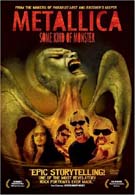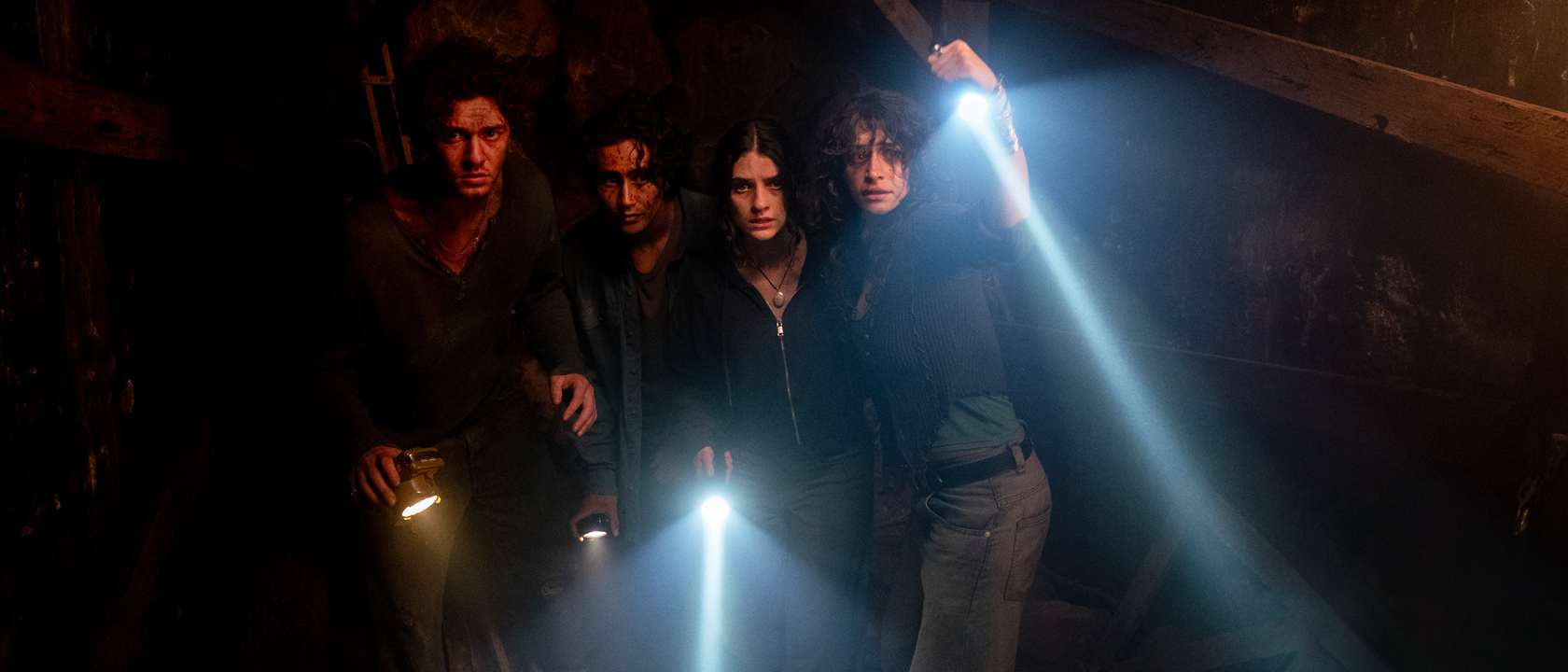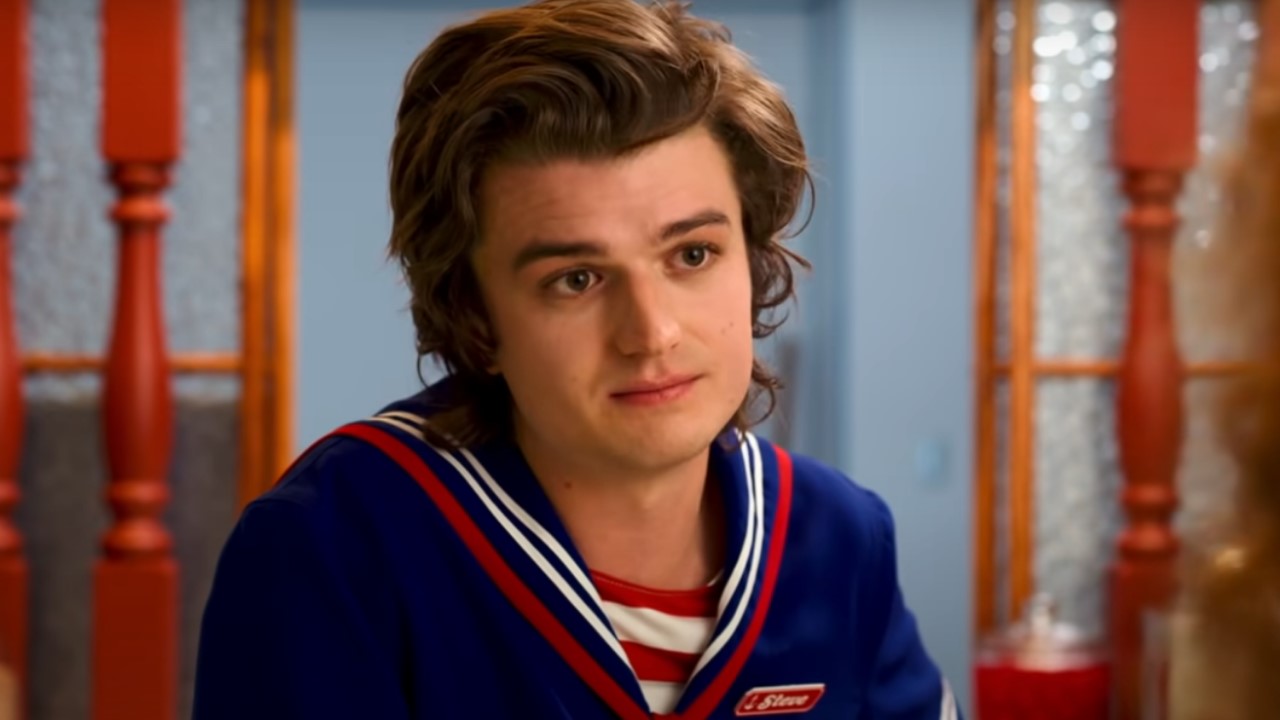Just watching the trailers for Metallica’s Some Kind of Monster you realize you are standing on the back of something very emotional, deeply personal, and fiercely painful. With the movie, you are bucked off and eaten alive. There is a level of intensity so high that there’s no way to escape being enthralled with the tangled relationships of the members of the band and how they attempt to heal the battle scars they gave to one another. Put the kids to bed, turn off the lights, crank the volume as high as it will go, and listen to men share their feelings. It’s human nature to want to belong, to be a part of a group, and feel as though you fit in; for Metallica, they are no exception. But when you have a group as creatively minded as these guys, and given the twenty years they’ve been playing music together, there are bound to be problems and butting heads. The movie follows the making of the album St. Anger and the dramatic turmoil between band members James Hetfield, Kirk Hammett, and Lars Ulrich, along with producer Bob Rock, who plays bass for the album due to the recent and upsetting exit of Jason Newsted.
Some Kind of Monster is unlike any other “rockumentary” or “behind the scenes,” and that’s the point. Instead of band members goofing off in desperate attempts to appear fascinating for a camera crew like they don’t belong on stage but on an episode of “Jackass,” Metallica is recorded arguing, tossing insults at one another, and unraveling as a group. The real life tension and frustration creates the movie and a hypnotic stare as you glimpse into their darkest time from inside the studio. They hire Phil Towle, a kind of group/sports therapist or performance coach to help them learn how to deal with their problems and really talk to one another.
What’s key is that there are no scenes cut because the moment became too intense, or someone became uncomfortable. The cameras absorbed it all and then show it perfectly interspersed with shots of the past and a rich blending of the band’s large collection of songs. They even capture a sit-down therapeutic confrontation between Lars and Dave Mustaine, who was kicked out of the group for alcoholism even though everyone at that time had the same problem.
There do seem to be a few times where the film drags here or there, but that’s mostly due to length and because the majority of it is shot like a fly on the wall during discussions and arguments. By the end, you see the arrival of Rob Trujillo as a welcome rebirth of the band. (He reminds them of deceased bass player Cliff Burton who died while they were on tour in Sweden.)
Some Kind of Monster works because these are really intelligent men with complex feelings that they aren’t afraid to express to one another (thanks to Phil). Once the credits role you are able to see them as individuals instead of a collective Metallica. Do they figure out how to make aggressive music without pouring in anger and dysfunction? How do you fuel the fire of creativity without scorching the others around you? I’ll be honest, you’re not going to ponder this one for days afterwards, but it’s a wild ride while you’re on it. Between lawsuits with Napster, James checking into rehab and not being present again for a year, dealing with family life, and pressures to create an album after being in the shadows, there is no question that fans will be ecstatic to see what’s been going on. If you weren’t a fan of the group before, you are now. Extras on the disc include additional scenes, highlights from festivals and premieres, a music video, two commentaries (one by the band and another by the filmmakers), and interviews with Metallica about the film. The additional scenes are critical and show more of the bands’ humor, extend other discussions, and display Lars’ changing hair. To mullet or not to mullet, that is the question. The only problem I saw with these add ons is that you have to select each one in order to view it. There is no PLAY ALL function to select and with forty extra clips it gets a little monotonous. I understand they formatted it that way because with some of the extras you can choose to watch with the filmmakers’ commentary, but still, you would think Paramount could put a break of text before each clip, naming it, and then let you pick to play all of them at once. You could always go back later and select the ones with commentary you wanted to hear.
Also included are scenes of them playing at a Raiders game, more from the Dave Mustaine meeting, lots more scenes of talking and eating in the kitchen, emotional controversy over Jason Newsted’s departure, and a trip to see Lars’ childhood home. These are great additions to the film and for someone willing to select each one, there is a payoff in what you’ll see.
The highlights from festivals and premieres, and exclusive interviews take a different turn. No longer are you watching the band members fight or joke with each other, now they step back and answer questions about the film itself. It’s almost strange how they relate to seeing themselves on screen and remember the feelings they had during different moments. When you’re watching the film, even though you know it’s real, in a small way, you view these men as characters. To see them talk about the movie objectively you realize immediately that, no, this is their actual life. By seeing them post-production you also get a chance to see their recovery and how they relate to one another now. They view the film as a truth serum and feel fortunate to have it documented as a way of learning where they’ve made mistakes. It created an openness between them and you can tell they uphold it to this day.
The commentary for Some Kind of Monster with James, Lars, Kirk, and Rob is sadly, pretty disappointing. It’s basically the same as anyone watching home videos of themselves; “look at your hair in that shot,” “nice shirt there,” “oh, that’s before I had my teeth worked on.” Fairly boring stuff with little insight. The focused interviews are much better. There are so many gaps of silence, about the only thing louder than the music is the crickets chirping in the background.
The filmmakers’ commentary, however, is very in depth with a constant flow of discussion and analysis of each of the band members. Sinofsky and Berlinger have the advantage of actually being there for the major events of the band, but because they are only indirectly involved, they look at each situation from a unique perspective. They also comment on, that because they are filmmakers, the emotionally charged scenes were horrible in one sense, but at the same time, they guiltily viewed it as great for the content of the film.
Metallica: Some Kind of Monster isn’t just about the band sticking together and finding a new bass player, it’s about where the Metallica piece of the jigsaw puzzle fits in with these three (and later four) different lives. The personal crisis each band member deals with is truly, and appropriately named, some kind of monster.
Stranger Things’ Joe Keery Shares Feelings On Possibility Of Fans Only Recognizing Him As Steve For Years To Come, And I Love This Take
'That's The Official Word': What The Cast Of Ted Lasso Has Said About Season 4
Tom Hardy Thinks The Oscars Stunt Category Is 'A Great Start,' However, He Also Explained Why 'It's Not Enough'











